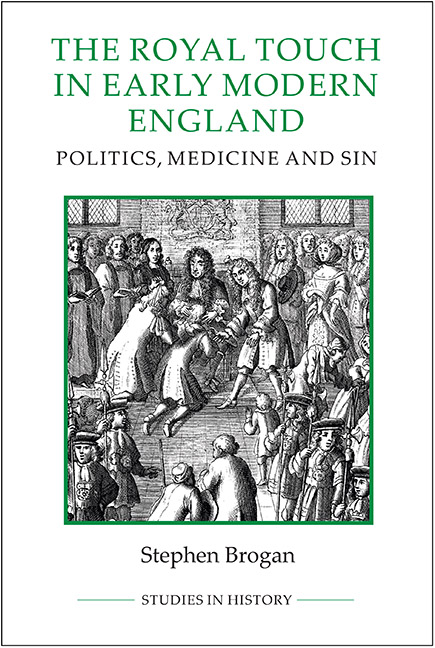Book contents
- Frontmatter
- Contents
- List of Illustrations
- List of Tables
- Dedication
- Acknowledgements
- Abbreviations
- Introduction
- 1 The origins and medieval history of the royal touch, 1000–1485
- 2 The Tudors: revival and reform of royal therapeutics, 1485–1603
- 3 The royal touch and the Stuart monarchy, 1603–1688
- 4 The ritual process of the royal touch, 1660–1688
- 5 The Restoration debate: the rise of ambivalence and scepticism, 1660–1688
- 6 The royal touch and the early English Enlightenment, 1689–1750
- Conclusion
- Bibliography
- Index
2 - The Tudors: revival and reform of royal therapeutics, 1485–1603
Published online by Cambridge University Press: 17 June 2021
- Frontmatter
- Contents
- List of Illustrations
- List of Tables
- Dedication
- Acknowledgements
- Abbreviations
- Introduction
- 1 The origins and medieval history of the royal touch, 1000–1485
- 2 The Tudors: revival and reform of royal therapeutics, 1485–1603
- 3 The royal touch and the Stuart monarchy, 1603–1688
- 4 The ritual process of the royal touch, 1660–1688
- 5 The Restoration debate: the rise of ambivalence and scepticism, 1660–1688
- 6 The royal touch and the early English Enlightenment, 1689–1750
- Conclusion
- Bibliography
- Index
Summary
Henry VII revived the royal touch after which it was practised by all the Tudors, although the evidence for Edward VI is weaker than for the others. The numbers touched by the Tudors are small though, when compared to Edward I, Edward II or Edward iii, or to the Stuarts. Yet the continuity with which the Tudors touched the sick meant that the ceremony became an established part of English royal ritual during the sixteenth century, whereas it might have been practised intermittently towards the end of the Middle Ages.
The fragmentary evidence reveals that the scale of Tudor thaumaturgy was initially very small, although an increase can be detected by the end of the sixteenth century. Between December 1491 and June 1505 Henry VII may have held fourteen ceremonies at which he touched a total of thirty-four people, averaging between two and three people per ceremony. Between January 1530 and December 1532 Henry VIII is recorded as having touched a total of sixty-five people on twenty-six occasions: although the number of ceremonies is greater, the average is still between two and three people. The records reveal that Henry VIII touched in London, as well as when he was on progress, and even in France. He held ceremonies at York Place, Westminster, Greenwich, Windsor, Woodstock, Grafton, The More, Havering and King's Langley, and at Calais when he visited François I in November 1532. The records are silent for Edward vi's reign and sparse for the reigns of Mary Tudor and Elizabeth I. Yet it is known that at Easter 1556 Mary touched a crowd of people who had scrofula that numbered ‘not above 20’. Elizabeth touched nine people when staying at Kenilworth in 1575, but towards the end of her reign she touched thirty-eight at Easter 1596. Easter was the most popular time to be touched, so this figure is probably indicative of the largest of Tudor ceremonies. In November 1596 she touched another ten people. The next year her chaplain boasted that she performed the ceremony every Sunday and feast day.
If it was usual for Henry VII to touch only two people at each ceremony, whereas by 1596 thirty-eight were touched at Easter, evidently the rite had become more popular during the intervening period. This was due in part to the constancy with which the Tudors practised it.
- Type
- Chapter
- Information
- The Royal Touch in Early Modern EnglandPolitics, Medicine and Sin, pp. 45 - 66Publisher: Boydell & BrewerPrint publication year: 2015



